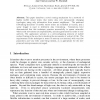Free Online Productivity Tools
i2Speak
i2Symbol
i2OCR
iTex2Img
iWeb2Print
iWeb2Shot
i2Type
iPdf2Split
iPdf2Merge
i2Bopomofo
i2Arabic
i2Style
i2Image
i2PDF
iLatex2Rtf
Sci2ools
EWSN
2004
Springer
2004
Springer
A Novel Mechanism for Routing in Highly Mobile ad hoc Sensor Networks
This paper describes a novel routing mechanism for a network of highly mobile sensor nodes that routes data over dynamically changing topologies, using only information from nearest neighbours. The preferred forwarding directions of mobile sensor nodes are modelled as vectors, and a scalar trigger is used to determine data forwarding. Simulations have demonstrated that this technique operates successfully in sparse networks, where node movements are unpredictable, and data generation by nodes is nonuniform. The application scenario is a self-configuring network of mobile nodes, floating in the sea, that is tracking the movements of a shoal of fish. The requirements of the technique in terms of memory are minimal, with very few parameters and very little code being needed, as is appropriate for the lowpowered microprocessors envisaged.
EWSN 2004 | Mobile Nodes | Mobile Sensor Nodes | Preferred Forwarding Directions | Wireless Networks |
| Added | 25 Dec 2009 |
| Updated | 25 Dec 2009 |
| Type | Conference |
| Year | 2004 |
| Where | EWSN |
| Authors | Jane Tateson, Ian W. Marshall |
Comments (0)

